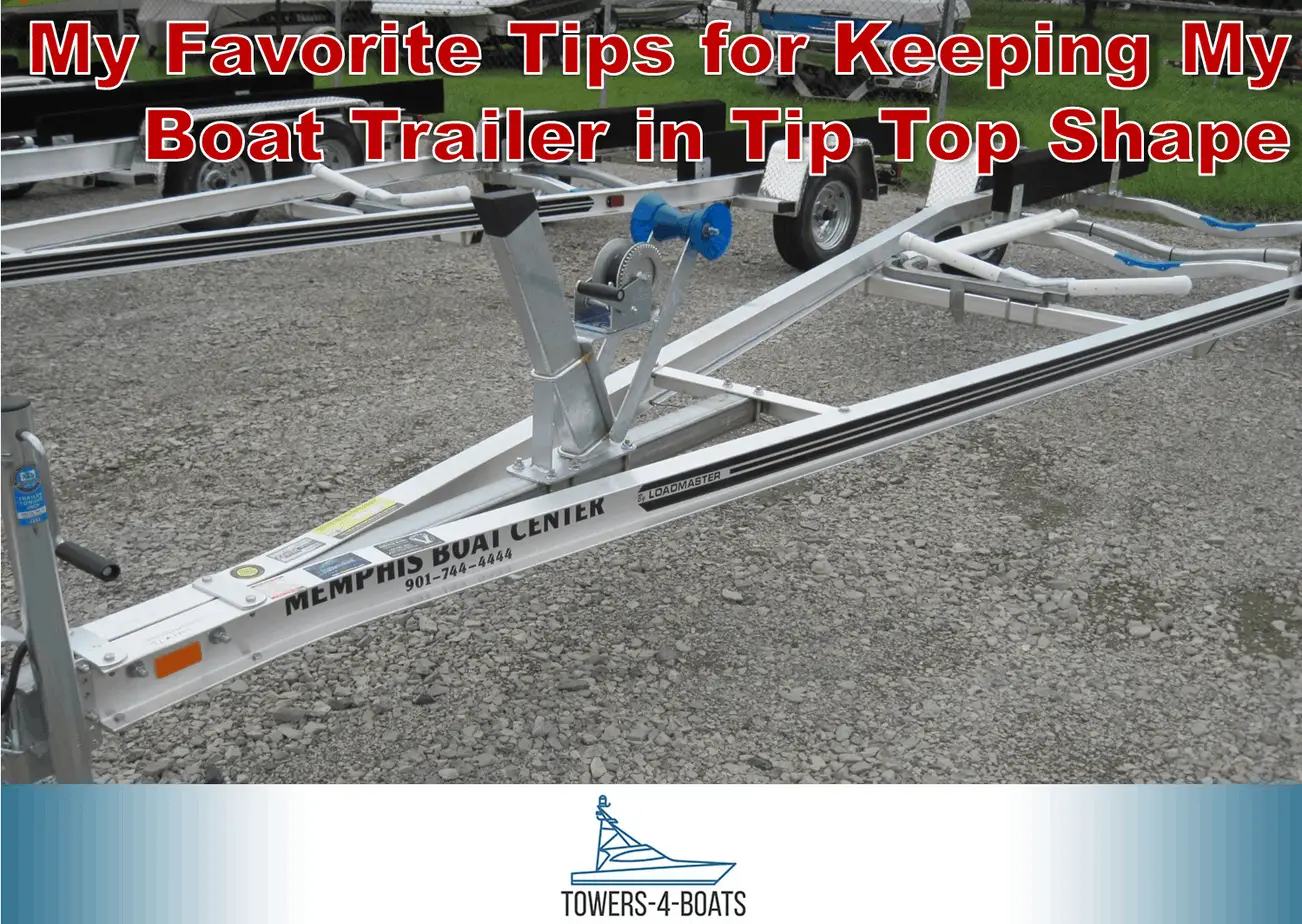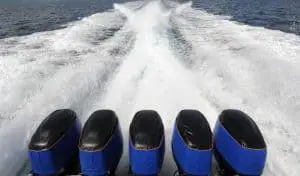Spruce Up Your Trailer for the New Season
There are six different means of describing love, according to the ancient Greeks. But I’m sure ancient Greek boaters had a word for “boat love” to describe “trailer love” and a different, even more, sophisticated word.
I found my trailer was looking a little shabby after I finished renovating my cruise. On the steel frame, there was some surface corrosion, one of the tail lights was not working properly, the spare tire was no longer retaining air, the carpet padding was rigid, and the trailer tongue jack was beaten up. It was time to show some affection in that trailer.
Trailer love‘s first rule is to not harm your boat. The last thing you want to do is mar the end of your pride and joy, so it’s best to empty the trailer first. You’re going to be grinding and hammering and painting and the last thing you want to do are mar the end of your pride and joy. In the workshop, I hoisted my boat with a chain drop attached to a beam and then rested it on a padded sawhorse.
Outside the trailer, the fenders, wiring and lights, spare tire, and those tired carpeted trailer bunks were wheeled away. Anything that came off the trailer was put in an old Tupperware plastic tub, so I didn’t lose any components. In the event they were needed again, all fasteners, including those that were old and ruined, went into Ziploc bags.
Scrape Off Loose and Pealing Paint
If your trailer is made of steel and it has surface rust, the removal of paint is job one. A cup brush was suggested by a friend who is an engineer, and it was very effective at removing paint, but be warned: it also has a nasty habit of shedding stainless steel wires and tossing them at such a pace toward your manhood that they become embedded in your pants.
To minimize the amount of bending necessary, Jack put the trailer up and placed it on jack stands, or sawhorses. Then grind, grind, and grind some more until all of the loose paint and any rust has been removed.
Look over the entire frame at the end of the grinding session, to see if any welds are broken and need repair. (I found one where the tongue was attached to the front of the frame.) To your job list, add any that you find.
Clean it with acetone for mild pitting or corrosion and then fill the gap with thickened epoxy. Vacuum the rest of the trailer as the epoxy is kicking, then wipe it clean.
Use a Good Primer Paint on Your Trailer
Priming, which is best-performed undercover, is the next step. I rolled the trailer back into the garage, but I covered the floor with plastic first; that made it much easier to clean up.
Loosen the lug nuts on the trailer wheels before you get out the primer, jack the trailer up on the jack stands, and remove the wheels.
You’re able to prime the whole trailer after donating some old clothing. I used the Rust-Oleum Primer for Rusty Metal. On every surface of the trailer, you want to get a primer, and this is dirty work. I used mini paint rollers to make it more comfortable and then tipped the paint out with my favorite sash brush, which is 3″ high. You can use spray cans as well, but you’ll need a lot of them as well.
I’m fond of my lungs and breathing is an activity I love, so when priming and painting the trailer frame, I wore a good respirator.
Call a nearby welder after the primer dries to patch any small cracks.
Now for the fun part: the reconstruction. In this trailer, you put a large amount of labor is, so treat yourself to the best new pieces. Do not reinstall something junky or worn out, because shortly, this is work you won’t want to do again.
Splurge and Buy New Parts
My favorite parts shop for trailers is etrailer.com. The employees are professional, the range is comprehensive, they have video reviews of the items, and they answer questions. For the front of the trailer, I ordered a new trailer jack and wheel, new LED taillights and side marker lights, and a new wiring harness. It still had some life in the old trailer jack, so I renovated it and set it aside to install on the back of the trailer; when you step aft of the trailer axle, that will avoid the dreaded popup.
Some surface rust was also present on the trailer wheels. I went through the same prep after wiping off the road grime and then painted both sides with spray paint. For these, one trick: treat yourself to some 3′ x 5′ index cards instead of masking the wheels off with tape, and place them in the gap between the wheel and the tire, overlapping each card by an inch or so to shield the tires from stray paint.
I sprayed the wheels with Rustoleum paint after priming, and they were ready to go.
How to Paint Your Trailer
One friend suggested that I use different paint colors for each coat, so I will be able to see if I missed any spots. I liked this idea, but it was difficult to find out exactly how much to buy for each painting.
I bought one gallon of Rust-Oleum Smoke Gray paint instead. I was beginning to dislike the work by the time the third coat of paint was applied. But the 27-year-old trailer was looking better than new when I stood back to enjoy my job.
The galvanized trailer fenders looked a little tatty now, so I gave them wire brushing, washing, and spray painting with a few coats of Rust-Oleum Cold Galvanized. The finish isn’t as hard as I’d like it to be, but the fenders look a lot better than before.
Check Your Boat Trailer Spare Tire
Beyond repair, the spare that was on the trailer was rusty, so I went into the junkyard. The toughest part of replacing a spare tire is finding out what size you need, but it makes it easy to replace a spare tire. Another way to make sure you don’t buy the wrong size is to make a little jig with a piece of wood and some nails sticking out of it where the lugs go, so you can tell immediately if the spare will match the trailer when you get to the junkyard.
There was a leaky stem valve on the spare I bought for $20, so I took it to a nearby shop to get the tire removed. Then I took the wheel home, fixed it (the same procedure as above), and returned it to replace the tire and the leaky valve stem. Restoring the wheel is far simpler when there is no tire on it, and much more satisfying.
Your Bearing May Need to be Repacked
Next up for your consideration are the bearings on the trailer, which are some of the most critical components. Remove the caps from the bearings and look at the grease. It’ll feel silky smooth and smell new if they’ve been repacked recently, and you’re in good shape. It is time to repack the bearings if it looks like a hardened, lumpy mess. On YouTube, here’s a decent video to show you how to repack trailer bearings.
Trailer Bunks
I began to imagine, now that the trailer had been painted, that the bottom of my boat was my own. I would rather rest my buttocks on a wide, comfortable platform given the alternative, and I have always admired the wide, cushy bunks covered with closed-cell foam that is perched on by high-end yachts.
My trailer bunks were cut to little more than 2 x 6 to match the outline of the ship’s bottom. I cut 1⁄4″ plywood to match the bunks’ length and width to replace them, rounded the corners with a jigsaw, and drilled some holes for countersunk flathead screws.
Then I taped off all the finished work with plastic for the painter and then mixed up some epoxy. I coated straight epoxy with the two initial bunks, then mixed up a thickened epoxy batch and added it to where the bunks would fit on the frame. As clamps, the screws worked. I wet out some 6″ wide fiberglass cloth I had lying around the shop on top of the new, wider bunks.
Eight hours later, I trimmed the edges of the fabric flush with the bunks with a sharp chisel after the epoxy on the glass cloth was firm but still easy to handle.
The next day, to remove the amine blush from the epoxy, I washed the bunks with warm water and a Scotch-Brite pad. Then the rough spots were sanded out, washed, primed, and painted. The bunks now matched the frame, but the padding was still required.
The closed-cell foam turned those cool, large bunks for my boat into a La-Z-Boy. “A friend had some leftover foam from his latest project, so I cut off his sheet with what I needed, two 6” wide strips and four feet long. With a flat edge and a utility knife, I cut his place, so it was a little rough. I used a fine-tooth table saw blade back in my garage to clean it up.
I put a strip of carpet tape down the middle to connect the foam to the bunks, then added a 3M 5200 bead around the edges. I used weights and clamps to keep it in position until the foam was on top of the bunks.
It was time to mount the lights and cables, with the foam bunks looking cushy enough for the Queen’s royal backside. Before you start, here’s a tip: those metal clips that came with the lighting kit are going to mar your paint surface, kink your wires and cut your hands. In the trash can, the perfect place to put those clips is. Instead, use wire links.
Replace the Wiring Connection
I stripped the wires back enough after sorting the harness so that the wires ran exactly straight, so there was about a half-inch where they met the wires from the lights. I slipped the shrink wire wrap covers to one side before welding. I slid the shrink tube over the joint after the joint had cooled and shrunk it with a heat gun to make the joint more waterproof.
LED lights must be grounded to operate properly, which ensures the ground wire is in direct contact with metal. I had to expose some of the metal for the earth to do its job after adding one coat of primer and three coats of paint.
I bolted the new trailer jack to the front of the trailer once that was finished and then took my reward: a test drive with the empty trailer to make sure that the lights worked. A lot brighter than the old bulbs were the new LED lamps.
Last Minute Check
The trailer looked fine, but I had time to focus on one of the great mysteries of life while I was taking it apart and brushing it with wire: why did the trailer rust in that one particular spot? Or the one here? Chances are, it was because it was possible to gather water there. So, when I put the trailer back together, I laid down a generous bead of silicone caulk anywhere it was possible to gather water. Where the lights were mounted on the trailer, where the fenders met the trailer, and where the wooden bunks met the trailer, I was still in bed.
The last final touch was to place the name of my boat on the trailer so that there would be no doubt as to who owned this restored masterpiece. I used reflective letters from mailboxes.
It is a lot of work to make your trailer perfect, but knowing that you and your beautiful boat can get safely down the road is also a good feeling. And after you’ve shown your trailer all this love, there’s no denying that your trailer will love you back for years to come.




